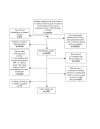Chronic kidney disease in gout in a managed care setting
- PMID: 21812963
- PMCID: PMC3174872
- DOI: 10.1186/1471-2369-12-36
Chronic kidney disease in gout in a managed care setting
Abstract
Background: To study the prevalence of chronic kidney disease (CKD) and its impact on allopurinol dosing and uric acid control among patients with gout.
Methods: This was a retrospective study using data from a large US health plan. Claims and laboratory data were analyzed for enrollees from the health plan database from January 2002 through December 2005. Patients with gout were identified from pharmacy and medical claims data based on the presence of codes for gout medication or gout diagnosis. Severity of CKD was determined using the estimated glomerular filtration rate (eGFR). Allopurinol titration was defined as a change in average daily dose from first prescription to last prescription of ≥ 50 mg.
Results: A total of 3,929 patients were identified for inclusion in this study, 39% of whom had CKD (based on having an eGFR < 90 mL/min/1.73 m2). Subjects with CKD were older (p < 0.01) and more likely to be women (p < 0.01), had a greater number of comorbid conditions (p < 0.01), and were more likely to be prescribed allopurinol (p < 0.01) compared to those with no CKD. The average starting dose of allopurinol was lower among those with CKD, and it decreased with worsening kidney function. Among the 3,122 gout patients who used allopurinol, only 25.6% without CKD and 22.2% with CKD achieved a serum uric acid concentration of < 6.0 mg/dL (p = 0.0409). Also, only 15% of allopurinol users had an upward dose titration (by ≥50 mg), but the average increase in dose did not differ significantly between those with and without CKD.
Conclusions: About two out of every five patients with gout in this population had CKD. Allopurinol doses were not adjusted in the majority of CKD patients. Serum uric acid control in gout was poor among patients without CKD and even worse among those with CKD.
Figures

References
-
- Krishnan E, Lienesch D, Kwoh CK. Gout in ambulatory care settings in the United States. J Rheumatol. 2008;35:498–501. - PubMed
-
- Wallace KL, Riedel AA, Joseph-Ridge N, Wortmann R. Increasing prevalence of gout and hyperuricemia over 10 years among older adults in a managed care population. J Rheumatol. 2004;31:1582–7. - PubMed
-
- Choi HK, Curhan G. Gout: epidemiology and lifestyle choices. Curr Opin Rheumatol. 2005;17:341–5. - PubMed
Publication types
MeSH terms
Substances
LinkOut - more resources
Full Text Sources
Other Literature Sources
Medical
Research Materials
Miscellaneous

